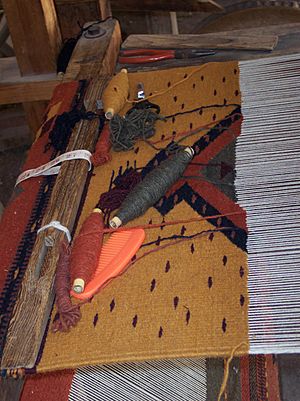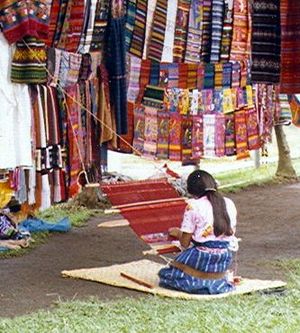Textiles of Oaxaca facts for kids
The state of Oaxaca in southern Mexico is famous for its beautiful textiles. These are often handmade items like embroidery and woven goods. Many of these are made using a special tool called a backstrap loom. Oaxaca is home to many different groups of native people. Each group has its own unique way of making textiles.
The main native groups in Oaxaca are the Zapotec, Nahua, and Mixtec tribes. Each of these groups added their own style to the clothing seen in Oaxaca today. Textiles and clothes can tell us a lot about a culture. By looking at them, we can learn about the tools used to make them. Many tools were similar across Mexico. However, some were more common in certain areas. This led to similar patterns and embroidery.
The clothes made in Oaxaca also show how these native groups see the world. They reflect their social structures too. For example, a cape-like garment called a tilma was only for upper-class men. It was made of cotton. Cotton was a luxury material because it was easier to work with than plant leaves.
Many old textile traditions from Mexico have disappeared. Climate change is one reason for this. Since many old styles are gone, we often learn about them from murals and sculptures. These artworks show how the textiles looked and how they were worn. As these older styles became less popular, a new style of native dress appeared. This modern dress is known as the Traje de Tehuana.
Ancient Mexican clothing still influences modern dress. Some garments have been passed down through time. They have changed slightly in fabric, materials, and patterns. The influence of old clothing on modern dress is clear. For example, the ancient tilma was a cotton cape for upper-class men. Today, the Rebozo (also called Sarape or Gabán) is a shawl worn by women. It is clearly influenced by the tilma. Many features of older clothing serve as a guide for patterns and embroidery in modern textiles.
Contents
How Oaxacan Textiles Are Made
Oaxacan textiles are made from different fibers. These include cotton or local silk. People often spin these fibers by hand. Traditional dyes come from natural sources. For example, the Huave, Chontal, and Mixtec people use Purpura pansa for purple colors. The Chontal and Mazatec people also use cochineal to get bright red colors.
According to Alejandro de Ávila B., Oaxaca has many different plants. This means it has the most types of fibers and dyes in Mexico. He says that Oaxaca's textiles are "unparalleled" in their technical skill.
Traditional clothes in Oaxaca include the huipil. This is a women's blouse made from several pieces of fabric. The ceñidor is a type of sash worn by the Mazatec. The paño is a Chinantec head covering. Oaxacan textiles are made using different weaving styles. These include plainweave, brocade patterns, and gauze weave.
The tools used to make these textiles can be seen in the finished product. In ancient Mexico, people used waist looms. These looms could only make fabric about an arm's length wide. Even though the fabric was narrow, waist looms made very neat and straight edges. This meant no extra work was needed to fix them. Many fabrics are made from natural resources. These include plant leaves and cotton. Plant leaves provide many fibers, which is good because they are natural and plentiful. This also helps with the dyeing process. Many bright colors in traditional dress come from natural dyes. These dyes create a vivid range of colors in native clothing.
Meaningful Patterns and Symbols
A textile expert named Irmgard Weitlaner-Johnson connects old spiritual beliefs with butterflies in Mazatec textiles. She wrote that Mazatecs believe the butterfly is the soul leaving the body. They think that the souls of people who have died can visit their families once a year. This happens on All Saints' Day and the Day of the Dead. Butterflies are most common then, and Mazatecs believe it is wrong to kill them.
Other patterns have meanings that are not always clear. One is a stepped pattern called xicalcoliuhqui. This means "twisted ornament for decorating gourds" in the Nahuatl language. Another is the double spiral ilhuitl, which means "fiesta day." Before the Spanish arrived, colors were linked to the four main directions. Yellow was for east, red for north, blue and green for west, and white for south. Another common pattern is a rectangle below the neckline of the huipil. Its exact meaning is unknown. However, it appears often in old books and historic textiles. It is still popular today.
Other Symbolic Uses of Textiles
Traditionally, Oaxacan women wear a red faja (a woven sash) around their waists. They do this to protect themselves from evil.
Images for kids






